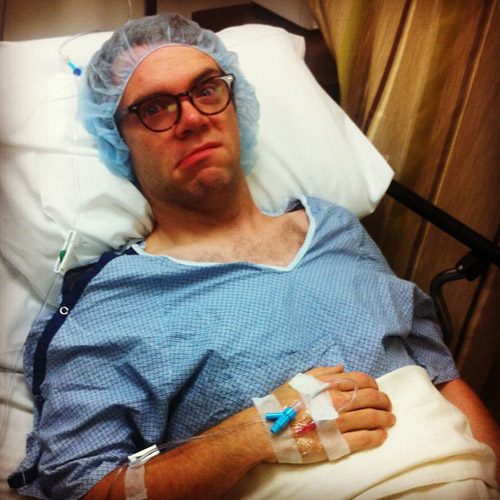With the state of my sex life being as it is, I just assumed the pain in my groin was a manifestation of an under-served libido. It was a numb pain, but as time went on it became more intense, just like love. Then I couldn't get out of bed. Time to call the doctor (and not Dr. Drew).
After my doctor ruled out a pulled groin or hernia, he assumed it must be an STD -- even as I explained that my sex life is almost as active as Lindsay Lohan's career. Convinced otherwise, he treated me for gonorrhea and chlamydia while he sent my blood for testing.
I wait. I go home. I'm convinced I'm dying. I write my bucket list and erase my browser history. The results come back.
"You tested negative for all STDs and HIV," says my doctor, "duh" says my brain, "and you're in good shape and general health, but the HCG (Human Chorionic Gonadotropin) hormone was found in your bloodstream. It's commonly found in pregnant women, but in non-pregnant individuals it is an indicator of cancerous cells that lead to the formation of tumors."
"Okay, but have we 100 percent ruled out that I'm not pregnant?"
Cancer is heavy. Like "buttermilk." It sounds good, but after eating it you're left feeling bloated and ashamed. I was sure that based on my general state of good health and high activity level that I couldn't have something extreme like, say, cancer. Just not a likely outcome of my balls hurting. Right? I had no family history of it.
But knowing my blood had pregnant lady tumor cancer hormones swimming around in it, I thought about how I would handle an actual diagnosis of testicular cancer.
I wait again. This time to see what those hormones really mean. After a long day of hearing Adele play on a loop at the urologist's office (seriously, men in a urologist office feel inadequate enough, without Adele giving us more of a complex), it turns out that these little tranny cancer cells in my body that were just waiting for the opportunity to transition into tumors were successful. I had a tumor. In my testicle. A cancerous tumor. BUTTERMILK.
There are moments that happen that are markers in the timeline of your life; a wedding, a birth, etc. I haven't had too many of these in my 30 years. Being single with no children, the most I've got is a graduation here, a loss of virginity there, possibly the discovery of Fresca. Now I've finally got something of real significance to add to the timeline;
Wednesday, August 8th, 2012 -- Get diagnosed with testicular cancer.
Lying there on the operating table I asked if I could keep what they were taking out of me. I couldn't. Life is hard.
Post-surgery, there's now a clearer picture of what's wrong with me- correction: what happened to me -- and what's next. Officially I have Stage 1 Nonseminoma Testicular Cancer IS, which means they caught it early but I'm so special I need further care to prevent cancerous cells from spreading to the rest of my body.

In a matter of three short weeks I went from your average comedian tweeting about Mitt Romney and Fresca to your average comedian tweeting about having cancer. As a comic, your instinct is to use this in some way, to have an experience and turn it into a bit. There are funny moments that come from having cancer, like people telling you about others they know have died from cancer to others wanting to take a picture with you (leaving you asking, "Just in case you don't see me again?"). I haven't found my bit yet. I don't know what it will be, or how this will come to define me. Right now the only thought running through my mind is, "I have cancer." Just that, on a loop, "I have cancer."
Chemotherapy starts on September 24th. I will lose my hair, along with various other side effects that are only appealing if you're into that sort of thing (in which case you're gross, sorry to inform you so bluntly). It's not real. Three months of my life devoted to being pumped full of poison just to save my life? I've performed on some crap shows before, but this gig, this takes the cake in the sh*tty department.
I'm still holding out hope that this is all one big colossal joke and that I'm really pregnant.
_________________________________________________________________
H. Alan Scott is a Writer, Comedian, Fresca Enthusiast. His article was originally posted in Huff Post Comedy on August 29, 2012.
Follow H. Alan Scott on Twitter: www.twitter.com/HAlanScott














